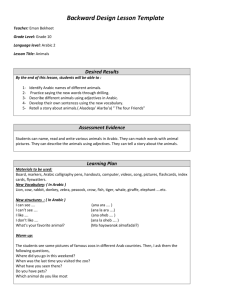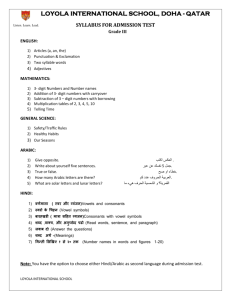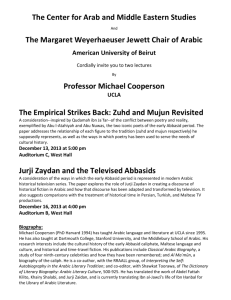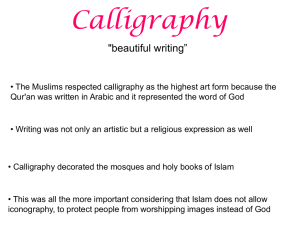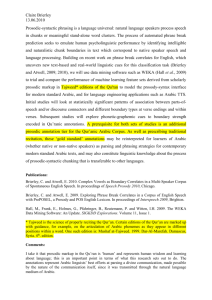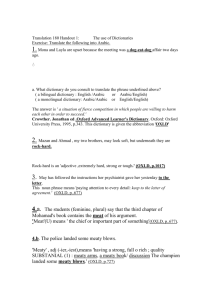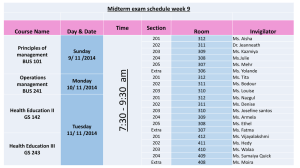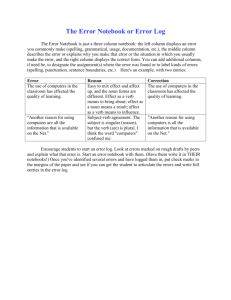You may either type your answers in the assignment`s .doc file, and
advertisement
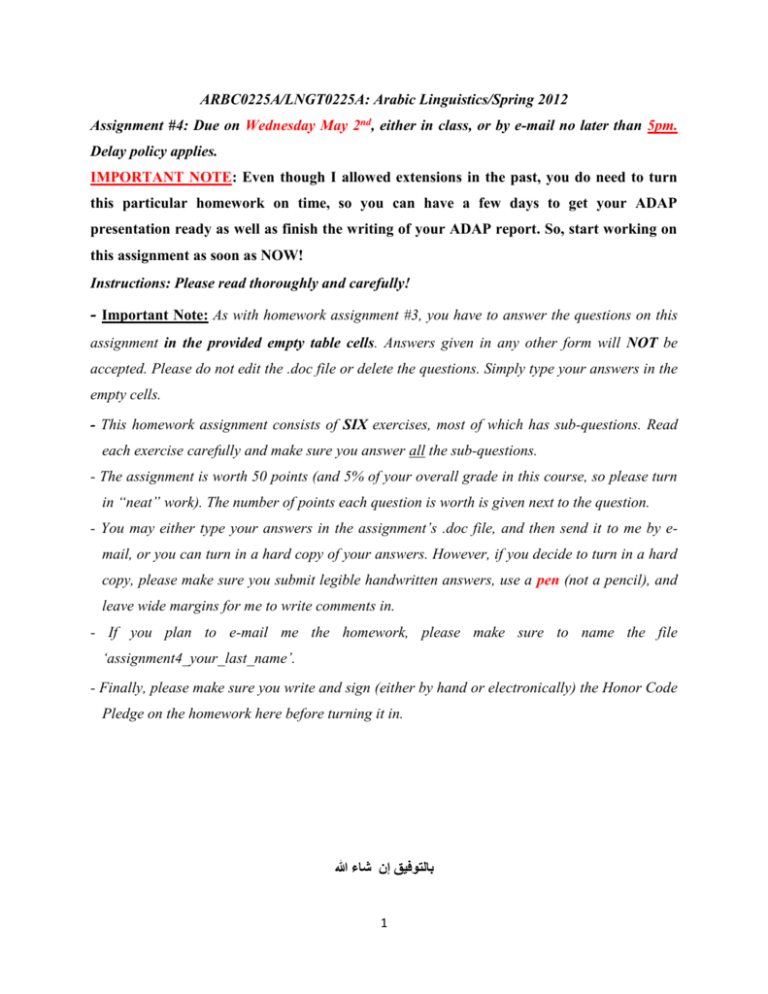
ARBC0225A/LNGT0225A: Arabic Linguistics/Spring 2012 Assignment #4: Due on Wednesday May 2nd, either in class, or by e-mail no later than 5pm. Delay policy applies. IMPORTANT NOTE: Even though I allowed extensions in the past, you do need to turn this particular homework on time, so you can have a few days to get your ADAP presentation ready as well as finish the writing of your ADAP report. So, start working on this assignment as soon as NOW! Instructions: Please read thoroughly and carefully! - Important Note: As with homework assignment #3, you have to answer the questions on this assignment in the provided empty table cells. Answers given in any other form will NOT be accepted. Please do not edit the .doc file or delete the questions. Simply type your answers in the empty cells. - This homework assignment consists of SIX exercises, most of which has sub-questions. Read each exercise carefully and make sure you answer all the sub-questions. - The assignment is worth 50 points (and 5% of your overall grade in this course, so please turn in “neat” work). The number of points each question is worth is given next to the question. - You may either type your answers in the assignment’s .doc file, and then send it to me by email, or you can turn in a hard copy of your answers. However, if you decide to turn in a hard copy, please make sure you submit legible handwritten answers, use a pen (not a pencil), and leave wide margins for me to write comments in. - If you plan to e-mail me the homework, please make sure to name the file ‘assignment4_your_last_name’. - Finally, please make sure you write and sign (either by hand or electronically) the Honor Code Pledge on the homework here before turning it in. بالتوفيق إن شاء هللا 1 Exercise #1: Predicting nouns! (10 points) Based on our discussion of CA noun morphology in class and in the textbook, answer the following questions. Then, use Hans Wehr to check if your predictions are correct. Comment on any discrepancies you find between your predictions and the words you find in the dictionary. Question Predictions Are your predictions correct? 1. If رَكَعmeans ‘to kneel,’ what do you expect ‘kneeling’ to be? 2. If فَلَحmeans ‘to farm,’ what do you expect ‘farming’ to be? 3. What do you expect ‘a person who does farming for living’ to be called? 4. The verb أبحرfrom the root بحْ ر (= ‘sea’) means ‘to travel by sea.’ What do you expect the word meaning ‘sailor’ to be? 5. What do you expect ‘lake’ (literally, ‘a little sea’) to be? 6. If قَبَرmeans ‘to bury (the dead),’ what do you think مَقبَرةmeans? 7. If حَلَقmeans ‘to shave,’َ what do you expect the word for ‘barber’ to be? 8. If جَراحةmeans ‘surgery,’ what do you expect the word for ‘surgeon’ to be? 9. If ضَحَكmeans ‘to laugh,’ what do you expect ‘a laugh’ (that is, ‘an instance of laughing’) to be? 10. If غَسَلmeans ‘to wash,’ what do you expect the word meaning ‘laundromat’ (literally, ‘a place for washing’) to be? 2 - Comment on any findings from Exercise #1 here. Exercise #2: Semantics of construct states! (5 points) Identify the semantic relation between the first and second elements of a construct state إضافةin each of the noun phrases given in the following table. The semantic relations are given to you below, for convenience. Semantic relations in construct state noun phrases: (i) identity (ii) partitive/quantitative relationship (iii) possession (iv) agent relationship (v) object relationship (vi) إضافةَغيرَحقيقية Semantic Relation Construct state noun phrase 3 َ َ مشاهدةَالتلفزيون َ َ عالقةَحب َ َ رئيسَأمريكا َ َ عملَالواجب َ َ رَبعَساعة َ َ لطيفَالكالم َ َ سفرَالطالب َ َ )assistantَ=َمساعدَاألستاذَ(مساعد َ َ شوربةَخضار Exercise #3: Compounding Tenses! (5 points) Translate the following English sentences into CA/MSA, in light of our discussion of compound tenses. English Arabic 1. By June of 2013, I will have worked 5 years at this university. 2. When we got to class, the teacher had already started the lecture. 3. He had studied English before his family moved to the United States. 4. They were going to study in Egypt, but now they will go to Jordan instead. 5. He was watching TV when his wife came back from work. 4 !Exercise #4: Going Negative )(5 points Negate each of the Egyptian Arabic sentences in Column A and write the full negative sentence in Column B. If there are multiple ways to negate a sentence, state them all. Column B Column A باذاكرَكلَيومَفيَالمكتبةَ . َ هادخلَكليةَالطبَالسنةَالجايةَ(الجايةَ=َالقادمة)َ . َ فيهَمشاكلَكتيرةَفيَاالقتصادَاالمريكيَ َ. َ أختيَمدرسةَفيَمدرسةَثانويةَ . َ أحمدَنامَ َ. َ اناَواصدقائيَبنلعبَرياضةَكلَأسبوعَ . َ هيَأجملَبنتَفيَالجامعةَ َ. َ عندهمََ3امتحاناتَاألسبوعَالجايَ(الجايَ=َالقادم)َ َ. َ أناَمشغولَجداََ َ. َ عالقتيَبيهمَانقطعتَ َ. َ 5 Exercise #5: (In)definiteness! (10 points) For each of the blanks in the following MSA sentences, write الـwhere required. In Column B, for each case you use الـ, state the reason why الـis required, based on our discussion of definiteness in class and in the textbook. The first word is done for you as an example. Column B Column A Final noun in a definite construct stateَ:الناس ََولكنَهناك،كلَالـناسَيقولونَإنهمَيريدونَ__سالم َ )‘world’َ=ََ(عالم.__حروبَكثيرةَفيَ__عالَم ََ،شاهدتَأمسَ__برنامجاَعنَ__تاريخَ__شرقَ__أوسط َ َ.لكنَفيَالحقيقةَماَأحببتَ__برنامج َ ََجميلةnatureَ__خريفَهوَفصليَ__مَفضلَألنَ__طبيعة ََأيضاَ__دراسةَتبدأَفيَ__جامعاتَوأتعرف.و__جوَلطيف َ َ.علىَ__أصدقاءَجدد َ Exercise #6: The Writing Code! Based on the information and discussion presented in The Writing Code, answer the following questions. A. What is cuneiform writing? When and where did it develop? What kind of writing system is it? (5 points) 6 B. What is the rebus principle? How would you write the following two Arabic words using the rebus principle? (2.5 points) ‘( أَحبابloved ones’) [Hint: Look for أَحin the dictionary.] ‘( عجماءbeast’) [Hint: Look for عاجin the dictionary.] C. Do you think the root-and-pattern morphology of Arabic words makes it easier or harder to represent Arabic words in a pictographic writing system? Explain your answer. (2.5 points) D. What is a syllabary? State briefly how Sequoyah used it to invent a writing system for Cherokee. Then, in light of our discussion of syllable structure in Arabic, can Arabic be written using a syllabary? Why? Why not? Support your answer with examples from Arabic words such as كتابَ–َجامعةَ–َانقطاعَ–َقرأت, etc., and their syllable structures. (5 points) 7 8



